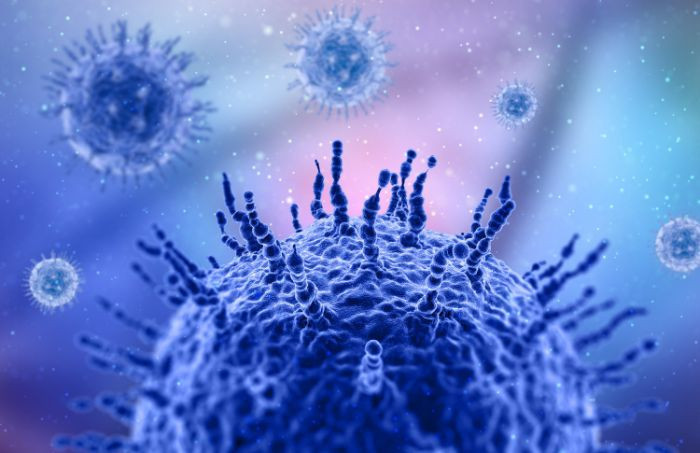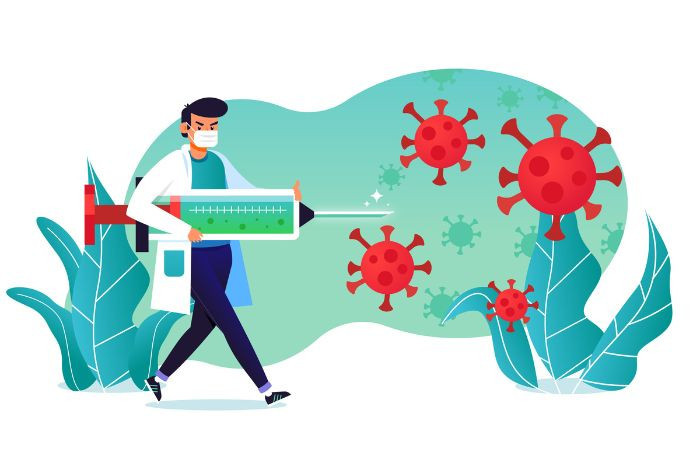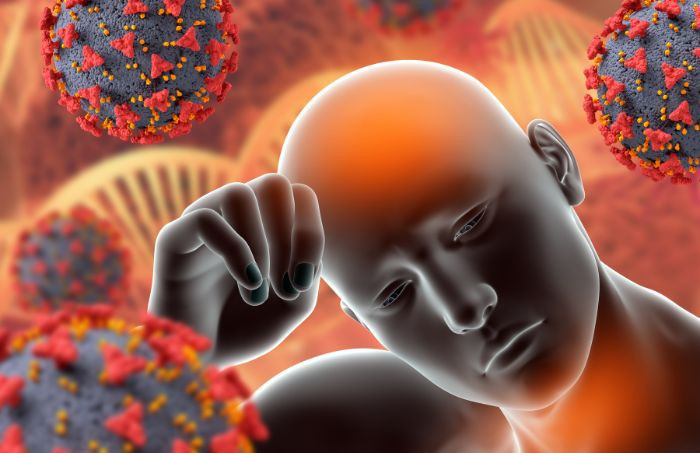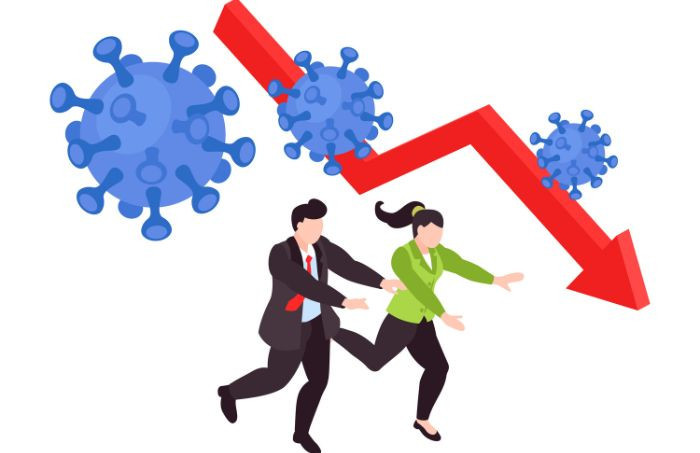Common Infectious Diseases: Online Consultation with Doctor
It is very important to discuss the symptoms and exposure risks regarding such illnesses.

Nowadays, curing infectious diseases like influenza, pneumonia, fever, cough, and body allergies are not a big deal. People tend to let these issues resolve themselves. But, if you do not cure it properly these diseases start to bother you in a very uncomfortable way. It is very important to discuss the symptoms and exposure risks regarding such illnesses.
Viral infections such as COVID-19 are prevalent. Once you get this nasty disease, you must quarantine for about 2 weeks before the public meeting. It is suggested to stay aside and consult your doctor virtually. However, timely cure, treatment, and diagnosis can lead you to health.
Introduction to Infectious Diseases:
Infectious diseases or illnesses are caused by pathogenic microorganisms. These are called bacteria, viruses, fungi, or parasites. These infectious diseases tend to spread from one person to another. They impact individuals, communities, and sometimes globally.
On the other hand, non-infectious diseases are those that do not spread from person to person and are mostly inherent. They differ from infectious diseases as the pathogens do not cause them. Nowadays, online consultation with doctor can fix all these infectious and non-infectious diseases.
Difference between Infectious and Non-Infectious Diseases
As it is mentioned earlier, both these diseases are different from one another. Pathogens cause one and the other is either inherited or happens by some other circumstances. Well, fret not. You can get a virtual doctor consultation for all these factors. Here are some points to elaborate on the difference between infectious and non-infectious diseases. You can see the checklist of differences:
- Infectious Diseases Causes
- Transmission
- Treatment
1. Infectious Diseases: Causes
Such diseases are caused by pathogens like bacteria, viruses, etc., and can spread from person to person. Non-infectious diseases, however, aren't caused by pathogens and can't spread between individuals.
2. Transmission of Infectious Diseases
Infectious diseases can be highly transmitted through direct contact, airborne particles, contaminated surfaces, or vectors like mosquitoes. Non-infectious diseases are often linked to lifestyle, genetics, and environmental factors and typically aren't contagious.
3. Treatment
Infectious diseases might require antibiotics, antivirals, or specific medications to target the underlying pathogen. Non-infectious diseases often necessitate lifestyle changes, medications, or surgical interventions. Virtual online doctor consultations can treat this issue.

Common Infectious Diseases
Here are some of the most common infectious diseases. Let's have a look:
- Influenza
- Common Cold
- COVID-19
- Pneumonia
- Gastroenteritis
- Tuberculosis (TB)
1. Influenza (Flu)
Influenza viruses lead to high fever, cough, body aches, and fatigue. But don't worry. Virtual primary care and resting can treat the flu better. Well, there is no need for self-medication. Influenza recovers itself within a week by taking preventive measures like hand hygiene and safe food handling. But, if the symptoms are out of control, do seek professional guidance.
2. Common Cold
It is caused by various viruses and patients show symptoms like sneezing, runny nose, sore throat, and mild fever. Get your virtual doctor consultation right now. It might stay for 2-3 days and recover itself by proper resting.
3. COVID-19
This respiratory illness is caused by the novel coronavirus (SARS-CoV-2), leading to symptoms ranging from mild respiratory issues to severe pneumonia. Hence, people with COVID-19 are suggested to stay at home in quarantine. For that reason, virtual primary care is the best option.
4. Pneumonia
It is a lung infection caused by various viruses such as influenza, respiratory syncytial virus RSV, and SARS-CoV-2. In pneumonia, patients show symptoms like fever, coughing, and flu. Difficulty in breathing is one of the most common symptoms of pneumonia.
As the virus penetrates deeper in the lungs, the infection and inflammation increase. It can also damage the lung tissues. Pneumonia leads to severe respiratory distress. The diagnosis of pneumonia involves chest X-rays, blood tests, and respiratory samples. Medication for pneumonia can be done with proper rest and regular medication. The oxygen supplement and hospitalization are also prescribed in some serious cases.
5. Gastroenteritis
It is often caused by viruses or bacteria, resulting in diarrhea, vomiting, abdominal pain, and dehydration. It is generally known as stomach flu. The viruses behind this cause are rotavirus and norovirus. Patients might face vomiting, nausea, abdominal pain, and frequent fever. It is caused mostly due to eating contaminated food.
6. Tuberculosis (TB)
An infectious bacterial disease affects the lungs, causing extreme coughing, chest pain, weight loss, bleeding in coughing, and fatigue. Patients suffering from tuberculosis feel extreme discomfort in coughing and sometimes experience blood with the saliva. TB is treatable with powerful antibiotics and constant prevention of drugs.
Most Common Non-Infectious Diseases
Non-infectious diseases differ from infectious diseases in that pathogens do not cause them and can't spread between individuals. Here are a few examples and differences:
- Cardiovascular Diseases
- Chronic Respiratory Diseases
- Cancer
- Diabetes
- Autoimmune Diseases
1. Cardiovascular Diseases
These include conditions affecting the heart and blood vessels, such as coronary artery disease, heart attacks, and strokes. Unlike infectious diseases, they result from factors like high blood pressure, cholesterol, smoking, and lack of exercise rather than from pathogens.
2. Chronic Respiratory Diseases
It includes asthma, chronic obstructive pulmonary disease (COPD), and occupational lung diseases fall into this category. They are caused by long-term exposure to irritants, smoking, or genetic factors, not by infectious agents.
3. Cancer
Cancer refers to abnormal cell growth, and its various forms are caused by genetic mutations, environmental factors (like UV radiation or chemicals), or lifestyle choices (such as smoking or poor diet). Unlike infectious diseases, cancer isn't contagious.
4. Diabetes
Both type 1 and type 2 diabetes are metabolic disorders caused by genetics, lifestyle factors, and insulin-related issues. Diabetes can lead to serious complications if not treated well. It can affect the heart, blood vessels, eyes, kidneys, and nerves. They're not transmitted from person to person like infectious diseases. It is generally inherent.
5. Autoimmune Diseases
Conditions like rheumatoid arthritis, lupus, and multiple sclerosis are caused by the immune system attacking the body tissues. They're not infectious and can't be spread.
Seeking guidance is mandatory in such cases.
Your doctor can suggest when to consult him and online consultation with a doctor can fix many issues and can be beneficial in managing these conditions, allowing individuals to access guidance, treatment plans, and ongoing care conveniently.

Risk Factors for Infectious Diseases
Factors such as weakened immune systems, lack of vaccination, poor hygiene, travel to disease-prone areas, and close contact with infected individuals increase the risk of contracting infectious diseases.
- Weakened Immune System
- Lack of Vaccination
- Poor Hygiene
- Travel to Disease-Prone Areas
- Close Contact with Infected Individuals
- Environmental Factors
1. Weak Immune System
Many online consultation services offer the perfect treatment for the boost of immunity. The immune system plays an important role in defending against pathogens, so compromised immunity increases vulnerability. Try to eat and stay healthy so that you can boost your immune system.
2. Lack of Vaccination
Not being vaccinated or under-vaccinated against preventable infectious diseases increases the risk of contracting these illnesses. Vaccines offer immunity against specific pathogens, reducing the chances of infection and transmission.
3. Poor Hygiene
Poor hygiene is one of the most common reasons to get sick. Inadequate hygiene includes improper or lack of hand washing, living an unclean life, and not taking proper care of your surroundings. Make sure to wash your hands before every meal so you can not develop infectious agents.
4. Travel to Disease-Prone Areas
Traveling to areas where certain infectious diseases are going on can increase the chances of exposure. Different regions might have specific infectious diseases that are more common, and travelers might lack immunity against those pathogens.
5. Close Contact with Infected Individuals
Direct contact with infected people, such as through coughing, sneezing, kissing, or sharing utensils, can lead to the transmission of infectious diseases. Some pathogens spread easily in crowded places or through close interactions.
6. Environmental Factors
Certain environmental factors, such as weather changes, any disaster, or geographical disturbances, can rapidly spread infectious diseases like, stagnant water can become an infestation for mosquitoes, growing the risks of diseases like malaria or dengue fever.
These risk factors help in adopting preventive measures such as vaccination, keeping good hygiene, avoiding high-risk areas or behaviors, and seeking timely medical advice through online consultations with doctors to reduce the risks of getting infectious diseases.

How Infectious Diseases Spread
Infectious diseases have high chances to spread through direct contact with infected people, (coughing, sneezing), touching contaminated surfaces, contaminated food, water, and vectors like insects or animals carrying the viruses.
Infectious diseases spread through different mediums, and understanding these means of transmission is very important in preventing their proliferation. Here's a detailed view of how these diseases spread:
- Direct Contact
- Respiratory Droplets
- Airborne Transmission
- Contaminated Surfaces or Objects (Fomites)
1. Direct Contact
Direct contact is the biggest and most common cause of viruses and bacteria to spread. It can be spread through kissing, sharing the same utensils for food, and many other ways. So, keep your hands clean and properly sanitized.
2. Respiratory Droplets
Respiratory infections, like the common cold, flu, or COVID-19, spread through respiratory droplets produced when an infected person coughs, sneezes, talks, or breathes. These droplets make a home in the mouths or noses of nearby individuals, leading to infection. Such infections spread through mere touch.
So, avoid touching unnecessary areas in public places and transportation. Make sure to wear a mask and gloves when you are out. A hand sanitizer can save you from many hygiene management issues. So, keep one with you wherever you go!
3. Airborne Transmission
Some infections can spread through smaller respiratory droplets that remain suspended in the air for an extended period. Measles, tuberculosis, and certain types of influenza can be transmitted via airborne particles, especially in enclosed spaces with poor ventilation.
It is very crucial to understand hygiene and separate the eating utensils from the patients. Make sure not to share the same things with the sufferer otherwise, you can catch the illness easily.
4. Contaminated Surfaces or Objects (Fomites)
Pathogens can survive on surfaces or objects touched by an infected person. When healthy individuals touch these contaminated surfaces and then touch their eyes, nose, or mouth, they can introduce the pathogens into their bodies, leading to infection.
Understanding how infectious diseases spread helps in implementing preventive measures. These include practicing good hygiene, such as regular handwashing, covering coughs and sneezes, vaccination to build immunity, maintaining proper food and water hygiene, using insect repellents, and seeking medical advice through online consultations promptly if symptoms or concerns arise.
Food of Thought
Infectious diseases pose a significant health concern globally, and understanding their nature, transmission, and risk factors is very important. Seeking online consultation services with doctors. They offer valuable guidance, diagnosis, and treatment options, especially in managing infectious diseases.
Online doctors provide accessibility and timely healthcare services for individuals. Virtual care and online consultations offer convenient access to healthcare professionals, ensuring prompt attention and advice for infectious disease concerns. Try to maintain a healthy setup for your beautiful life as it can prevent major health issues.
TAGS:
online consultation with doctor virtual doctor consultation virtual primary care online consultation services Health Health Care


